Why these northern European destinations are the new capitals of cool
High above Eidfjord, rugged peaks dusted with remnant winter snow tower above quaint scarlet-coloured barns dispersed atop the lushest of emerald pastures.
Below is the almost audible, rapidly flowing Eio River, a short but strident watercourse that for centuries has been a prized source of wild salmon.
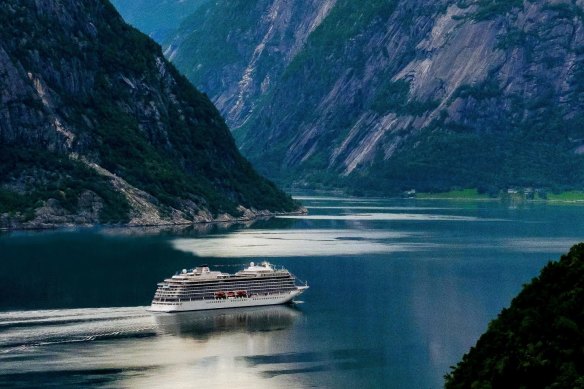
A Viking ship in Eidfjord, Norway.
Here in western Norway, with nary a person in cooee (or whatever the Nordic equivalent is) I’m walking in the ancient, leather-booted footsteps of Vikings and, or to be precise, more likely in the pathways of their Iron Age funeral processions.
On either side of the trail is a dark, birch-studded forest eerily strewn with up to 400 fenced-off Viking burial mounds or cairns (if only I’d known there were this many I would have worn black).
Each of the gravesites is topped with large moss-smoothed stones and forms a funereal rock garden of the ages that has been traced to between AD500 and AD1000.
The largest Iron Age burial ground in western Norway, archaeologists have uncovered broken pots, pearls, axes, arrowheads, the remains of swords and shields, a bronze brooch and, less surprisingly, human bones.
On the other side of the trail, I pass a collection of more prosaic heavy dormant farming equipment wisely kept well removed from the burial site, soon emerging back into the open country of a Nordic hamlet consisting of a handful or so of impossibly immaculate, seemingly deserted, red and white farmhouses.
Further along, on a rise above the township of Eidfjord, I spot my cruise ship, Viking Jupiter, its stiffly unfurled red, blue and white Norwegian swallowtail ensign fluttering in the determined breeze. The 930-passenger vessel is dwarfed, breathtakingly so, by the mammoth enclosed water world that is a fjord, one of nearly 1200 across Norway.
I’m in Scandinavia as part of a 15-day Viking Homelands cruise between Bergen, Norway’s second-biggest city, and Stockholm, the Swedish capital.
Just a few days into the cruise, this part of Europe, which I’m fortunate enough to have visited on other occasions and have grown to love, is again providing the starkest of contrasts to the rest of the Continent.
Everyone everywhere here in Scandinavia – without protest – switches from their native tongue to perfect English in an instant (not that it should be demanded by the visitor to these lands).
Crime rates tend to be so comparatively low to the rest of Europe, and indeed the world, Australia included, that it makes all the exportable Nordic noir TV crime series seem like works of the wildest invention.
In these high-earning, high-taxing yet supposedly happiest in the world nations, each still guided more or less by an ethos of the “greater good”, ostentatious displays of wealth are rare.
But there’s something more profound that is turning the world’s attention to Northern Europe.
Scandinavia has always been cool, what with its unrivalled design sense, the moderate temperaments of its peoples and its advanced social justice policies. You could even add to this list its proven propensity for earworm pop songs.
But it’s cooler than ever now, especially as the rest of continental Europe boils, at least this northern summer. The record hot days for Scandinavia’s main cities barely breach 35 degrees, and rarely so, though, of course, that could change.
Here in Eidfjord, where I’ve rugged up in a coat and scarf, it’s nowhere near those sort of highs, but if I wanted heat, I would have opted for a Mediterranean cruise not a Nordic one.
Arise, the new capital of Scandi cool
If Scandinavia is Europe made easy, I really couldn’t have chosen an easier or better way to experience it than with Nordic specialists Viking Cruises.
Founded by Torstein Hagen, one of Norway’s richest men, the line’s Viking Jupiter, with its unapologetically all-Scandinavian aesthetics and amenities, is to be my ocean-going home for more than a fortnight.
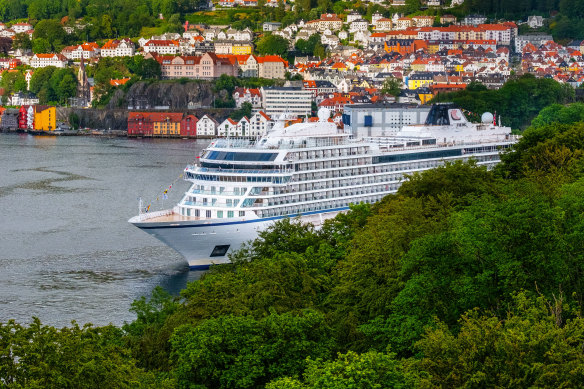
Viking Jupiter berthed below forests in Bergen.Credit: Getty Images
A few days before my passage through those Viking burial grounds, the ship is docked at Bergen, Norway’s second-biggest (though still relatively small) city, the beginning of my bounce around the Baltic.
The wharf is within easy walking distance of Bryggen, this attractive, compact city’s historic waterfront, dominated by a row of multi-coloured UNESCO World Heritage-listed signature wooden warehouses that have burnt down and been faithfully rebuilt numerous times over generations.
Bergen is considered Europe’s most important wooden-constructed city with its wealth of congenial colourful-timber buildings and houses.
There’s such a plethora of wood in this city of 300,000 people that it almost feels like I’m back in that Eidfjord forest.
However, it’s immediately apparent why timber is so ubiquitous here, Bergen being fabulously positioned below a dense fringe of pea-green forested, mist-shrouded hillside that looks and feels like the product of some sort of tryst between New Zealand and Tasmania.
As I wander one of the loveliest and best preserved of Bergen’s neighbourhoods beyond the more touristy Bryggen, I notice that, in true Scandinavian style, the colour-scheme of every single house, even the one with the daring purple and mustard paint job, is always aesthetically pleasing.
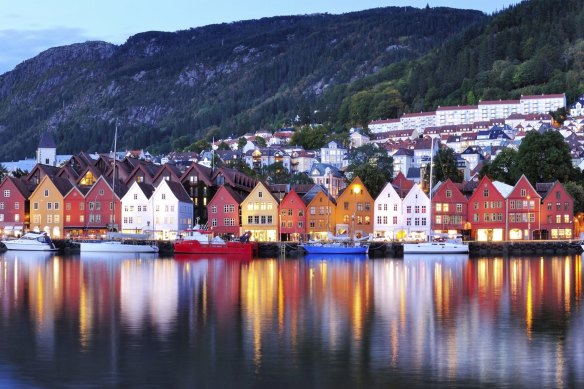
These striking coloured warehouses line the port in Bergen, in Norway.Credit: iStock
Departing a still wintry Bergen after a few days, we voyage overnight down Norway’s south-western coast towards Oslo in the east, with a brief stopover in Stavanger, a wholly pleasant shipping and shipbuilding city.
Since the early 1970s resources boom, Stavanger, with its ice-free harbour, has become the hub for Norway’s lucrative North Sea oil and gas exports, the controversial twin fossil fuels that have made this country (with a similar population to New Zealand) one of the planet’s wealthiest.
It’s Norway’s abundant gas reserves that have so far kept the rest of Europe warm following the ban on Russian supplies due to its invasion of Ukraine.
Stavanger, like Bergen, is also known for its timber houses. The city’s Old Stavanger showpiece neighbourhood perched above the waterfront, the setting for nearly 200 wooden buildings, most of them small, neat (as ever) and resolutely white-washed 18th century cottages with terracotta tiled roofs.
After not much more than a morning in Stavanger, with the sun finally shining but the temperatures remaining unseasonably chilly for the early summer, we depart the city for one of the early highlights of the voyage.
Long fairly low on the traveller’s priority list, along with Stockholm and Copenhagen, Oslo has in recent years reinvented itself with stunning results. Conde Nast Traveller even christened it “the new capital of Scandi cool”. It’s difficult to disagree, considering Oslo’s transformation in recent years.
The city features the relatively new and cutely dubbed Barcode urban revitalisation district, so named for its long row of edgy, modern high-rise buildings, which is in a former wasteland-like docklands area.
Then there’s the capital’s arresting ultra-modern Opera House, shaped a little like a deformed iceberg, while nearby is the high-rise Munch museum, the bold new home of the works of Edvard Munch, painter of The Scream.
If that’s not enough there’s also a new and vast National Museum with its own substantial collection of Munch paintings and drawings along with other major European masters while in 2026, a major new Museum of the Viking Age, replacing its predecessor, is due to open.
A once conservative Oslo appears to be warming to what counts for its eccentric side. Its harbourfront is lined with floating, pop-up-like, public saunas where locals and visitors alike can sweat it out in steamy, spruce-walled bobbing rooms.
These sweltering sessions are traditionally followed by a bracing dip in the fjord (during my visit at the start of summer the water temperature in the fjord was around 14C).
For me there’s no time for floating or stationary sauna sessions, let alone a frigid après dip in the fjord – well, that’s my story, anyway – as we’re set to sail to Denmark.
Freewheeling through Freetown and beyond
“Hash!” “Weed!” “Hash!” “Hash!” “Weed!” I’ve just ridden my shared bicycle, which I rented near our latest berth, into the open-air marijuana marketplace at Copenhagen’s so-called Freetown, better known as Christiania.
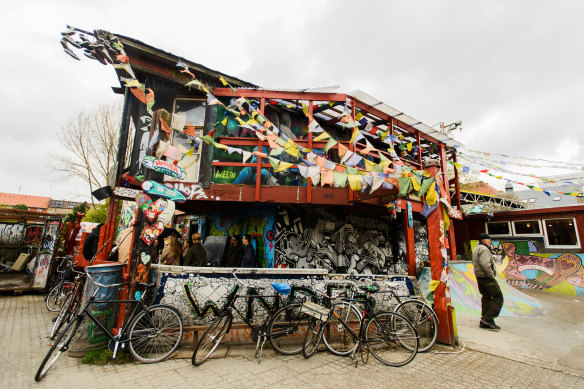
Freetown, Copenhagen – a gritty commune that began in the 1970s.Credit: iStock
It’s described variously as a community, commune and even micronation and, having visited Copenhagen on a few occasions, I’m surprised it’s still here, since the burghers of the Danish capital have long schemed to bulldoze it.
The ship had arrived in Copenhagen in the early morning after an overnight sailing from Aalborg, the architecturally rich Danish city and port located in Jutland to Denmark’s north, visited as part of the itinerary. It’s a manufacturing base for akvavit – speaking of stimulants, that near lethal Danish national drink can nudge 50 per cent alcohol content – as well as the site of the Utzon Centre, dedicated to the eponymous architect of the Sydney Opera House, and the last building designed by the great Dane.
Back in Christiania, which I notice even has its own alternative garbos who man a graffiti-daubed garbage truck, I learn that this gritty commune began in the 1970s when squatters occupied an erstwhile military base and essentially never left.
The bluntly named “Pusher Street” has become infamous (or famous, depending on your attitude) for its open trade of cannabis (strictly no photos), which is still illegal in Denmark.
Incongruously watching over all of this perpetually stoned counterculture is the landmark Christ Our Saviour Church, a towering late 17th century baroque building distinguished by its florid, almost fairytale-like (and typically Copenhagen) serpentine spire which can be climbed by visitors (though not this one).
In all my visits to Copenhagen, I’ve never ridden a bicycle in what is a world-renowned paradise for two-wheels with my call-in to Christiana part of a leisurely day-long spin around the city and its network of cycle paths.
All of my pedalling around this wonderful, wonderful city (Hay-gen not Har-gen) is enough to give you the munchies. Not for some weed, I hasten to add, but for some sustenance of the food variety, preferably in the form of smorrebrod.
Smorrebrod, which are also served aboard Viking Jupiter itself, are better known as the convertible of sandwiches – Scandinavia’s proverbial open-faced slices of deliciously topped rye bread.
Why hide the ingredients below a slice of bread when you can fully show them off? Pursuant of that philosophy, I’ve made a reservation at Fru Nimb, a two-kilometre ride from Christiania, and named after Louise Nimb, one of Copenhagen’s great restaurateurs of the 19th century.
It’s set slap bang inside Copenhagen’s beloved heritage Tivoli Gardens theme park – claimed to have been the inspiration for Walt’s Disneyland – where this specialist Danish sandwich eatery operates as part of the Nimb boutique hotel.
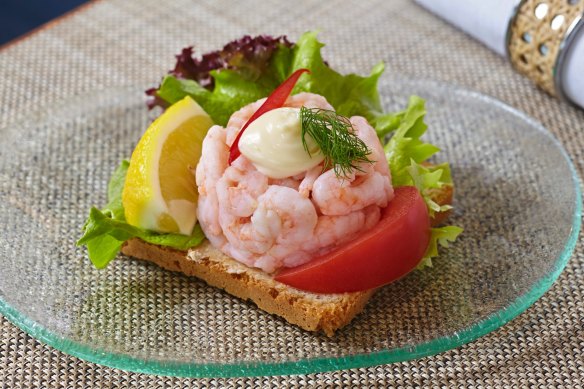
An open sandwich, this one on board with Viking.Credit: Viking Ocean Cruises
Fru Nimb’s menu features an array of varieties such as marinated herring with curry cream and (my choice) egg and prawn salad and slices of boiled egg topped with Danish caviar and watercress, teamed with a glass of champers.
Baltic bliss on Denmark’s fairytale idyll
I’m a little confused by the inclusion in my itinerary of both Germany and Poland.
It can be explained by the fact the voyage more or less traces the route of the Hanseatic League. This was the grouping of medieval trading cities across Northern and Central Europe, many belonging to Nordic nations (and some outside of that realm with direct Scandinavia antecedents).
To that end, having sailed from Copenhagen, we berth at Warnemunde, Berlin’s decidedly distant port, which the ship’s passengers can visit on an extended day trip.
I elect to take a train to the closer and considerably smaller Wismar, a charming port city and former Hanseatic League member in the northern German state of Mecklenburg – West Pomerania.
Wismar’s wealth was founded on its trade in two important northern European staples, herring and beer, with the city controlled by the Swedes between 1648 and 1903.
As a result, many of its handsome and historic buildings, survivors of wartime Allied bombings, are Swedish-influenced, with Wismar’s centrepiece medieval town square UNESCO World Heritage-listed.
After a full day in Germany, we’re back on the Baltic before midnight, veering back in the direction of Scandinavia and towards the Danish island of Bornholm, off Sweden’s southern coast and closer to it than Denmark itself.
We reach this enchanting idyll soon after dawn the next morning, and, after stepping ashore at Ronne, the main port on Bornholm, one of my first sights is of a pair of excitable middle-aged women standing next to the bicycles and dressed in bathrobes and slippers.
They’ve evidently wasted no time getting here having heard on the local grapevine that the Danish, royal yacht Dannebrog belonging to Denmark’s much-loved Margrethe II (mother-in-law of the Australian-born Crown Princess Mary), is departing from the waterfront after a low-key and little-publicised visit.
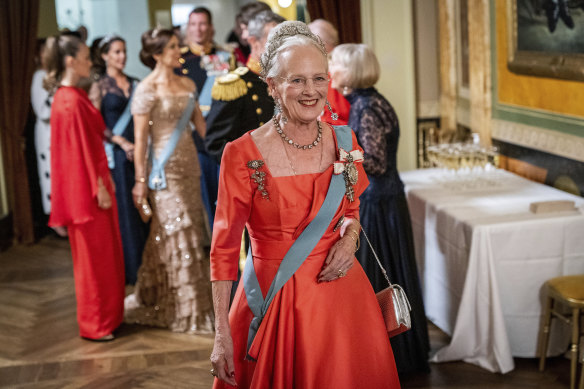
Queen Margrethe II of Denmark.Credit: AP
In an impressive, unheralded spectacle, white-uniformed officers and sailors are lined up along the deck of the white-hulled yacht with its extravagantly gilded bow glistening in the morning light.
I’ve got my own bike to worry about as I’ve pre-booked an electric one from a shop here in Ronne with the intention of visiting as many of Bornholm’s distinctive round white 11th and 12th century churches as I can before the ship departs the island.
Bornholm is home to more of these churches, made from granite and marvellously preserved, than mainland Denmark itself, with most of the four specimens on the island easily visited by bicycle.
The churches’ unusual fortress-like shape, complete with gun emplacements, was the result of a desire for protection from pirates who repeatedly attacked Bornholm during the crusades.
From Abba’s hideaway to pomp and circumstance
After Bornholm, there’s a day at sea which provides something of a welcome rest from a few weeks of relentless but rewarding foot-slogging and pedal pushing. Which way to the onboard spa?
It follows, on this decidedly action-packed voyage, an extended visit to the Polish port city of Gdansk, another Hanseatic League member and the home to the revolutionary Solidarity movement.
Eventually Viking Jupiter, nearing the end of its voyage, reaches the entrance to the spectacular Stockholm Archipelago.
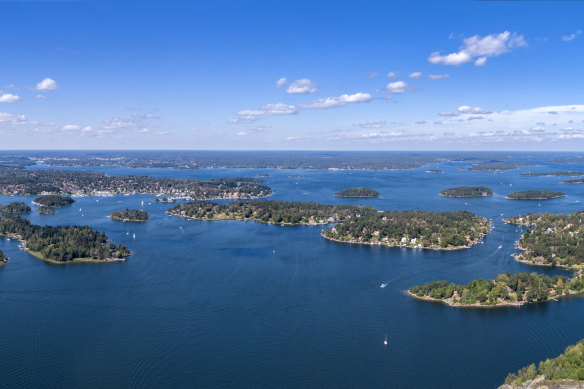
The Stockholm Archipelago from the air.Credit: iStock
This wildly picturesque water world of 30,000 islands, islets and rocky outcrops is unquestionably one of the most dramatic and compelling approaches to any port on the planet.
The ship’s passage through the Archipelago takes in shorelines festooned with meticulously maintained red and white Swedish summerhouses, or holiday houses, set against backdrops of wooded forests and fronted by sandy beaches.
Around here, as the captain points out from the bridge, is the isolated white cottage where Abba genius songwriting duo Bjorn Ulvaeus and Benny Andersson penned many of the Swedish pop sensation’s greatest hits.
Thank you for the music, guys, but I’m buggered if I can make it out. Oh well, there’s always a replica of the cottage at the Abba Museum in Stockholm.
It’s the quintessential waterborne city, built on and spread out over more than a dozen islands, which challenges Sydney for its aquatic beauty, and which we finally reach after a few hours or more negotiating the Archipelago.
There’s so much to recommend this city but one of my fondest memories from a previous visit to Stockholm is the city’s stirring and rather elaborate changing of the Royal Guards ceremony.
It begins and ends not in the grounds of the palace but through the streets of the capital as the music corps-accompanied soldiers march through the city.
Once they reach the outer courtyard of the palace – where these troops have been protecting the Swedish Royal Family since 1523 – the changing of the guard proves to be a grand spectacle, complete with a bonus tune for the assembled and appreciative crowd.
On this near-perfect and warm Stockholm Sunday, the city’s laid-back citizens are revelling, en masse and in various states of undress, in the Nordic summer sunshine.
It’s the final day of my bounce around the Baltic with a no-hassles Scandinavia, sans riots, record heat, petty robberies and other Continental inconveniences, and it really has proved itself to be Europe made easy.
Five things to do aboard the ship
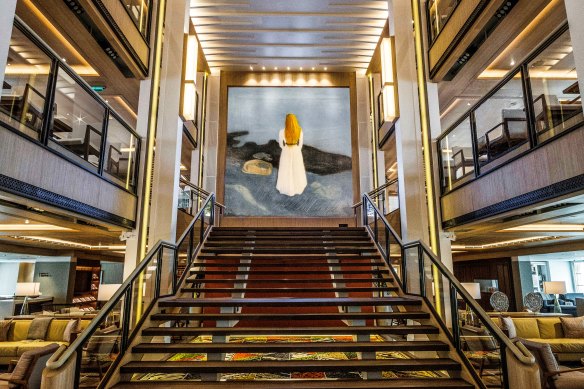
Viking’s ships showcase the digitised works of Norway’s most acclaimed artist, Edvard Munch.
Make a moment for Munch
An exclusive partnership with Oslo’s Munch Museum allows Viking’s vessels to showcase the digitised works of Norway’s most acclaimed artist, Edvard Munch in the form of onboard “Munch Moments” presentations in the ship’s deck one Living Room.
Take a self-guided art tour
Each of Viking’s nine ocean-going ships include impressive and extensive collections of Nordic art, including some original Munch prints. You can view all the modern and classic artworks, deck-by-deck as part of a detailed app-downloaded self-guided tour
Savour Scandinavian cuisine
Head to the Explorers’ Lounge, where at the restaurant Mamsen’s you can order a range of Norwegian specialties, including open sandwiches and brown cheese (don’t worry, you’ll love it) waffles.
Submit to the snow grotto
One of the ship’s most distinctive features is its “snow grotto”, part of the onboard Nordic-style spa and sauna complex, the perfect place to recharge and revitalise after a day of foot-slogging or pedal-pushing on shore.
Take high tea in the Wintergarden
Among many striking, design-led features is the Scandinavian trellised, wood-topped Wintergarden, where guests take afternoon tea overlooking the heated pool with its retractable dome roof that allows year-round swimming.
THE DETAILS
CRUISE
Viking Cruises’ 15-day Northern European “Viking Homelands” voyage from Stockholm to Bergen, or vice versa, starts from $9595 a person with a $2000 flight credit on offer per couple. The fare includes 11 shore excursions. There are departures available between May and August 2024 and April and August, 2025. See viking.com.au
FLY
Qatar Airways flies from Sydney to Oslo, with air and rail connections to Bergen, as well as to Stockholm via its Doha, Qatar, hub. See qatarairways.com
MORE
visitnorway.com
visitdenmark.com
visitsweden.com
The writer travelled as a guest of Viking Cruises.
Sign up for the Traveller Deals newsletter
Get exclusive travel deals delivered straight to your inbox. Sign up now.